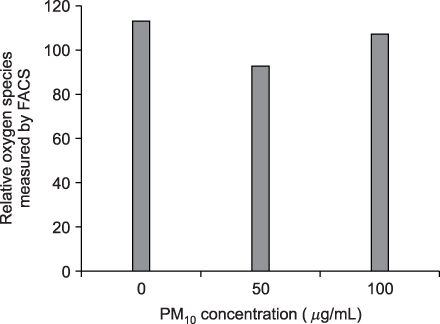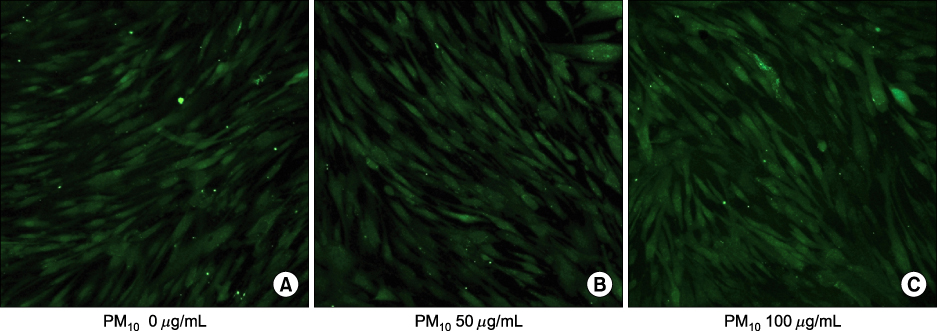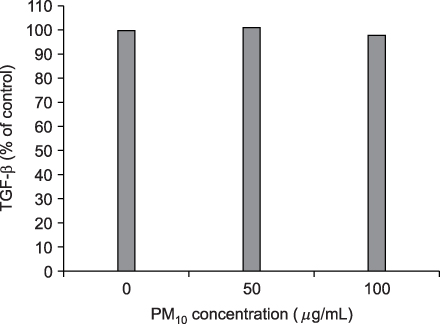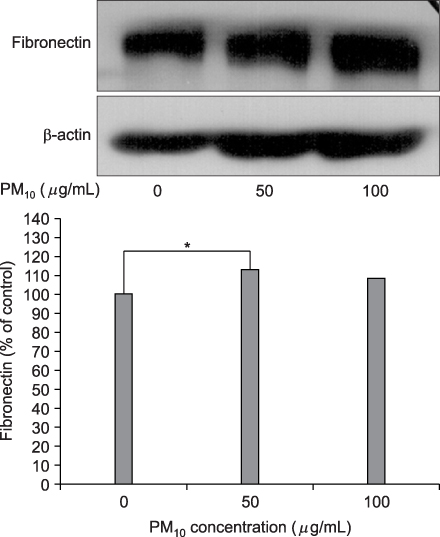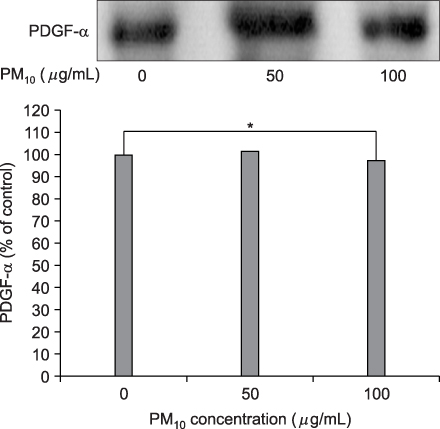Tuberc Respir Dis.
2009 Dec;67(6):528-535.
The Effect of Particulate Matter 10 from Asian Dust on the Production of Reactive Oxygen Species, TGF-beta, NF-kappaB, PDGF-alpha and Fibronectin in MRC-5 Fibroblast Cells
- Affiliations
-
- 1Gachon University of Medicine and Science, Incheon, Korea.
- 2Division of Pulmonology, Department of Internal Medicine, Gachon University Gil Hospital, Incheon, Korea. jsw@gilhospital.com
Abstract
- BACKGROUND
Dust clouds blown by the wind from the arid deserts of Mongolia and Northeast China are known as Asian dust storms. Ambient particulate matter with a diameter <10 micrometer (PM(10)) is associated with the exacerbation of respiratory diseases and increased mortality of heart and lung disease patients. The fibrotic effects of PM(10) of Asian dust to pulmonary fibroblast cells are unknown. This study examined the production of reactive oxygen species (ROS), TGF-beta, NF-kappaB, PDGF-alpha and Fibronectin in fibroblasts exposed to Asian dust particles. METHODS: Air samples were collected using a high volume air sampler (Sibata model HV500F) with an air flow of 500 L/min for at least 6 hours. The MRC-5 cells were exposed to 0, 50 and 100 microgram/mL of PM(10) for 24 hours. ROS was detected by measuring the level of oxidized DCF using FACS. TGF-beta, NF-kappaB, PDGF-alpha and fibronectin were detected by western blotting. RESULTS: There was no increase in the ROS, TGF-beta and PDGF-alpha levels in the MRC-5 cells exposed to PM(10). The NF-kappaB level was higher in the MRC-5 cells exposed to 50 and 100 microgram/mL of PM(10) for 24 hours. The fibronectin level in the MRC-5 cells after 24 hours incubation with 50 microgram/mL PM(10) was significantly higher than the control group (PM(10) 50 microgram/mL 113.27+/-8.65 of control, p=0.005). CONCLUSION: PM(10) from Asian dust increases the activation of NF-kappaB and fibronectin expression in MRC-5 fibroblast cells.
MeSH Terms
-
Asian Continental Ancestry Group
Blotting, Western
China
Dust
Fibroblasts
Fibronectins
Heart
Humans
Lung Diseases
Mongolia
NF-kappa B
Particulate Matter
Pulmonary Fibrosis
Reactive Oxygen Species
Transforming Growth Factor beta
Wind
Dust
Fibronectins
NF-kappa B
Particulate Matter
Reactive Oxygen Species
Transforming Growth Factor beta
Figure
Reference
-
1. Bell ML, Davis DL. Reassessment of the lethal London fog of 1952: novel indicators of acute and chronic consequences of acute exposure to air pollution. Environ Health Perspect. 2001. 109:Suppl 3. 389–394.2. Donaldson K, Stone V, Clouter A, Renwick L, MacNee W. Ultrafine particles. Occup Environ Med. 2001. 58:211–216.3. Park JW, Lim YH, Kyung SY, An CH, Lee SP, Jeong SH, et al. Effects of ambient particulate matter (PM10) on peak expiratory flow and respiratory symptoms in subjects with bronchial asthma during yellow sand period. Tuberc Respir Dis. 2003. 55:570–578.4. Donaldson K, Stone V. Current hypotheses on the mechanisms of toxicity of ultrafine particles. Ann Ist Super Sanita. 2003. 39:405–410.5. Becker S, Soukup JM, Gilmour MI, Devlin RB. Stimulation of human and rat alveolar macrophages by urban air particulates: effects on oxidant radical generation and cytokine production. Toxicol Appl Pharmacol. 1996. 141:637–648.6. Kim JH, Jeon HK, Kim MK, Kyung SY, An CH, Lee SP, et al. Particulate matter from Asian dust storms induces the expression of proinflammatory cytokine in A549 epithelial cells. Tuberc Respir Dis. 2006. 60:663–672.7. Sheppard D. Transforming growth factor beta: a central modulator of pulmonary and airway inflammation and fibrosis. Proc Am Thorac Soc. 2006. 3:413–417.8. Thannickal VJ, Horowitz JC. Evolving concepts of apoptosis in idiopathic pulmonary fibrosis. Proc Am Thorac Soc. 2006. 3:350–356.9. Hwang HJ, Kang SJ, Kang SE, Park YM, Kim HK, Roh CU. Single particle characterization of aerosol samples collected during Asian dust storm events and non-Asian dust period in Incheon. Proceedings of the 2007 Environmental Societies Joint Conference. 2007. 2007 May 2-4; Busan, Korea. Seoul: Korean Society for Atmospheric Environment;179–182.10. Baek KW, Chung JD. Study on the yellow sandy dust phenomena in Korean peninsula and chemical compositions in fine particles at background sites of Korea. Korean J Sanit. 2004. 19:9–18.11. Park KS, Kim YJ, Yoon JY, Kyung SY, An CH, Lee SP, et al. Particulate matter 10 from Asian dust storms induces the expression of reactive oxygen species, NF-kappaB, TGF-beta and fibronectin in WI-26 VA4 epithelial cells. Tuberc Respir Dis. 2008. 65:504–511.12. Jiang Z, Seo JY, Ha H, Lee EA, Kim YS, Han DC, et al. Reactive oxygen species mediate TGF-beta1-induced plasminogen activator inhibitor-1 upregulation in mesangial cells. Biochem Biophys Res Commun. 2003. 309:961–966.13. Rennard SI, Bitterman PB, Crystal RG. Response of the lower respiratory tract to injury. Mechanisms of repair of the parenchymal cells of the alveolar wall. Chest. 1983. 84:735–739.14. Junn E, Lee KN, Ju HR, Han SH, Im JY, Kang HS, et al. Requirement of hydrogen peroxide generation in TGF-beta 1 signal transduction in human lung fibroblast cells: involvement of hydrogen peroxide and Ca2+ in TGF-beta 1-induced IL-6 expression. J Immunol. 2000. 165:2190–2197.15. Churg A, Brauer M, del carmen Avila-Casado M, Fortoul TI, Wright JL. Chronic exposure to high levels of particulate air pollution and small airway remodeling. Environ Health Perspect. 2003. 111:714–718.16. Shukla A, Timblin C, BeruBe K, Gordon T, McKinney W, Driscoll K. Inhaled particulate matter causes expression of nuclear factor (NF)-kappaB-related genes and oxidant-dependent NF-kappaB activation in vitro. Am J Respir Cell Mol Biol. 2000. 23:182–187.17. Quay JL, Reed W, Samet J, Devlin RB. Air pollution particles induce IL-6 gene expression in human airway epithelial cells via NF-kappaB activation. Am J Respir Cell Mol Biol. 1998. 19:98–106.18. Chandel NS, Trzyna WC, McClintock DS, Schumacker PT. Role of oxidants in NF-kappa B activation and TNF-alpha gene transcription induced by hypoxia and endotoxin. J Immunol. 2000. 165:1013–1021.19. Jiménez LA, Thompson J, Brown DA, Rahman I, Antonicelli F, Duffin R, et al. Activation of NF-kappaB by PM10 occurs via an iron-mediated mechanism in the absence of IkappaB degradation. Toxicol Appl Pharmacol. 2000. 166:101–110.
- Full Text Links
- Actions
-
Cited
- CITED
-
- Close
- Share
- Similar articles
-
- Particulate Matter 10 from Asian Dust Storms Induces the Expression of Reactive Oxygen Species, NF-kappaB, TGF-beta and Fibronectin in WI-26 VA4 Epithelial Cells
- Asian Dust Particles Induce TGF-beta1 via Reactive Oxygen Species in Bronchial Epithelial Cells
- Role of Reactive Oxygen Species in Transforming Growth Factor - beta1 - inuduced Fibronectin Secretion and alpha - Smooth Muscle Actin Expression in Human Lung Fibroblasts
- Rutin inhibits osteoclast formation by decreasing reactive oxygen species and TNF-alpha by inhibiting activation of NF-kappaB
- Lipid peroxidation, NF-kappaB activation and cytokine production in neutrophil-stimulated pancreatic acinar cells

